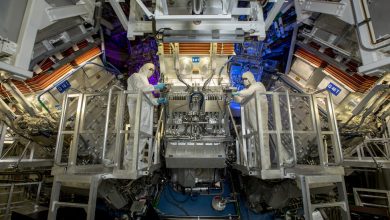A Stunning Eclipse, a Moon Race and Other Space Events in 2024

India landed a robot on the moon and NASA brought pieces of an asteroid back to Earth to study. A green comet illuminated night skies and a “ring of fire” eclipse captivated spectators from Oregon to Brazil. SpaceX launched nearly 100 rockets, and Japan and Europe put powerful new space telescopes into orbit.
For space and astronomy lovers, these were some of the biggest events of 2023. The year ahead promises even more memorable happenings on launchpads, in orbit and around the solar system.
Here’s a look at what to expect in 2024. The New York Times will provide updates on these and other events in an interactive Space and Astronomy Calendar that you can sign up for at NYTimes.com/spacecalendar.
Crucial Events on the Path Back to the Moon
NASA wants to put American astronauts on the moon’s surface in the years ahead with the Artemis III mission. Before that can happen, though, many things have to go right, and two of the most important are scheduled for 2024.
The first is the Artemis II mission. NASA introduced the four astronauts of Artemis II last year. As soon as November, the four could travel around the moon and back. They would be the first humans to travel near the moon since 1972, when the Apollo 17 mission concluded. To fly in 2024, NASA will need to resolve issues with a heat shield on the astronauts’ spacecraft, as well as overcome other potential delays.
The second hurdle is that the Orion capsule can only orbit the moon — it doesn’t land. Astronauts need another vehicle to head to the surface. For the moment, that is a version of Starship, the spacecraft that is being built by SpaceX, the private spaceflight company founded by Elon Musk. But Starship needs a lot of work before it will be ready to carry astronauts to the moon.
Prototypes of Mr. Musk’s Starship launched twice in 2023, and each mission ended in a fiery blast. SpaceX has said it wants to fly the next Starship test early in 2024; whether it succeeds or fails, flights of more prototypes could follow. If SpaceX gets the next Starship flights right, NASA’s prospects of putting the next man and the first woman on the moon will improve in the years ahead.
A Total Eclipse Over North America
The celestial spectacle of 2024 will be the “Great North American Eclipse.” On April 8, the moon will get in the way of the sun, darkening the Earth during the day time. The eclipse’s broad path starts in Mexico, crosses into Texas, continues up through Arkansas and Missouri into Southern Illinois, crosses into Indiana and Ohio, then darkens western New York and states in New England before ending in Canada’s eastern provinces.
If you live in the path, get ready for visitors. (You can’t book travel to the path of totality soon enough.) And if you plan to observe the eclipse — from anywhere — it’s time to order eclipse glasses or other protective viewers.
New Rockets and Rides to Space
Falcon 9 rockets, built and operated by SpaceX, have become the dominant way to get to space. The launcher or its Falcon Heavy variant flew 96 times in 2023, with every flight to orbit a success. But SpaceX should expect new competitors on launchpads in 2024. They include:
-
Vulcan, a rocket built by United Launch Alliance, a joint venture of Boeing and Lockheed Martin. The rocket’s engines are built by Blue Origin, the space company founded by Jeff Bezos of Amazon. It could fly on Jan. 8.
-
Ariane 6, a European rocket. The European Space Agency has been without a dedicated vehicle to get to orbit recently, forcing Europe to rely on SpaceX and others to get spacecraft out into the solar system. After a series of delays, Ariane 6’s first flight could occur in June.
-
H3, a Japanese rocket. This vehicle launched for the first time in March 2023, but it failed in its attempt to put an imaging satellite into orbit. A second attempt may happen as soon as Feb. 15.
-
New Glenn, a rocket from Blue Origin. Mr. Bezos’s company has flown tourists to the edge of space in its smaller New Shepard vehicle. Its large orbital launcher could debut in 2024, shaking up private spaceflight if it proves to be successful.
New vehicles could also visit the International Space Station. Dream Chaser, a space plane built by the company Sierra Space, may carry cargo to the station for the first time this year. Additionally, Starliner, a capsule built by Boeing, may finally carry a crew of astronauts to the outpost in orbit on April 14 after years of delays.
Lunar Traffic Jam
Three missions attempted to land on the moon in 2023. Only one, Chandrayaan-3 from India, succeeded. Four additional missions — and perhaps even more — will also try to complete a lunar landing in 2024:
-
SLIM, a Japanese mission, should be the first lunar landing attempt of 2024, on Jan. 20. The small, experimental spacecraft launched in September and is already orbiting the moon.
-
Two other missions come from private companies, with NASA as their primary customer. Astrobotic, a Pittsburgh company, will launch its Peregrine lunar lander on Jan. 8, which could attempt to set down near the Ocean of Storms on the moon’s near side in February. Intuitive Machines of Houston will send its own lander toward the moon’s south pole as early as mid-February.
-
China is also planning its fourth moon landing. Chang’e-6 could head toward the moon’s far side in May, gathering samples of moon rock and dust to bring to Earth for study.
Other missions are more tentative. The Japanese company Ispace, which crashed its first lander last year, could make a second attempt late this year. And Intuitive Machines has ambitions of sending two more NASA-sponsored missions to the moon in 2024.
Journeys Around the Solar System
There’s a vast solar system out there, and missions large and small will set out to explore it.
The biggest is Europa Clipper, a NASA spacecraft headed to Jupiter’s moon, Europa, in October. Europa has an icy exterior concealing a vast ocean that scientists say may have the right conditions for life. After Clipper arrives at Europa in 2030, the spacecraft will attempt no landing there, but it will study the moon during dozens of flybys.
Two new spacecraft could also head to the red planet no earlier than August as part of the small NASA ESCAPADE mission. The spacecraft will orbit Mars and study the magnetic bubble that surrounds it.
In October, the European Space Agency will launch the Hera mission to the asteroid Dimorphos. It will study the effects of an earlier mission, NASA’s Double Asteroid Redirection Test, which slammed into Dimorphos in 2022 to test whether altering a space rock’s trajectory could protect Earth from future asteroid strikes.





